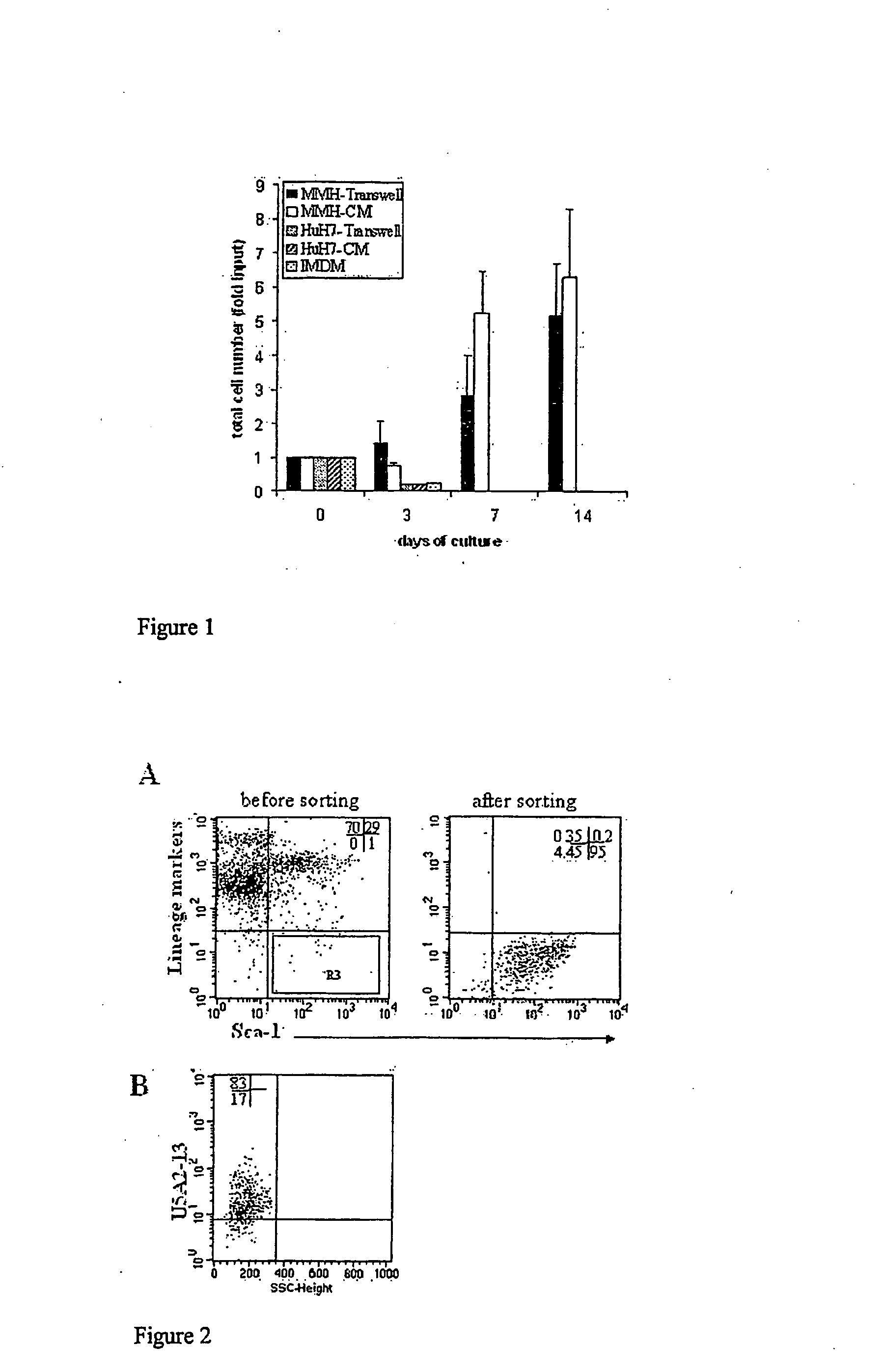Conditioned cell culture medium, method to obtain the same and use of it for maintenance, proliferation and differentiation of mammalian cells
a technology of conditioned cell culture and culture medium, which is applied in the direction of blood/immune system cells, hepatocytes, biocide, etc., can solve the problems of high expectations for so-called cellular therapy and gene therapy in the past few years, high cost of maintenance and/or differentiation toward specific differentiated programs of stem cells, and difficulty in the separation of generated cells from feeder cells
- Summary
- Abstract
- Description
- Claims
- Application Information
AI Technical Summary
Problems solved by technology
Method used
Image
Examples
example 1
Expansion and Differentiation of Murine Bone Marrow Hematopoietic Cells in Culture with MMH-Conditioned Medium
[0054] Bone marrow (BM) cells were cultured in MMH-conditioned medium for 14 days to a density between 20 and 40×103 / cm2 in a 25 cm2 flask. Every two days half of the MMH-conditioned medium was substituted with fresh medium. At different culture times, the cells are picked and counted evaluating, then, their expansion in comparison with the number of cells at the beginning of culture.
[0055] In FIG. 1 are reported the results of bone marrow hematopoietic cells cultured in MMH-conditioned medium. The results are compared with the culture of the same cells in simple medium (IMDM), in medium conditioned by either hepatoma or MMH cell lines (HuH7-CM or MMH-CM, respectively) HuH7-Transwell in the presence or in absence of a semipermeable membrane respectively) or in co-culture with either hepatoma or MMH cell lines in the presence or in absence of a semipermeable membrane (HuH7-...
example 2
MMH-Conditioned Medium Promotes the NK Differentiation of Murine Hematopoietic Stem Cell Precursors
[0059] The hematopoietic stem cells (Sca-1+Lin− and “Side Population”) were cultured to a density between 3 and 18×103 / cm2 in a 24 wells plate and cultured for 14 days in MMH-conditioned medium as described in the example 1.
[0060] As shown in Table 2, after two weeks MMH-CM promoted a significant expansion of SP- and Sca-1+Lin− derived cells (>100-fold and >40-fold, respectively). A large proportion of these cells were U5A2-13+ (74% and 43% for SP- and Sca-1+Lin− derived cells, respectively; Table 2), indicating that hematopoietic progenitor cells differentiated toward NK cell phenotype when cultured in MMH-CM.
[0061] Moreover, single sorted Sca-1+Lin− cells were isolated, deposited by FACS into individual wells and cultured in MMH-CM. After 14 days, 27 out of the 120 single cells plated gave rise to a clone; among them six were analyzed as individual clones and found U5A2-13+ (74±10...
example 3
MMH-Conditioned Medium Promotes Endothelial Cells Differentiation of Human Cord Blood Stem Cell Precursors
[0063] The hematopoietic stem cells purified from human cord blood (CD34+CD133+) were cultured in a 24 wells plate (3×105 / well) and cultured for 3 weeks in MMH-conditioned medium. MMH-conditioned medium promoted a significant expansion of stem cells-derived cells (>8-fold). A large proportion of these cells (about 50% of stem cells-derived cells) were CD31+CD144+, resulting in a more than 30-fold increase of CD31+CD144+endothelial cells. These data indicate that hematopoietic progenitor cells from human cord blood differentiated toward endothelial cells when cultured in MMH-CM.
PUM
| Property | Measurement | Unit |
|---|---|---|
| Time | aaaaa | aaaaa |
| Composition | aaaaa | aaaaa |
| Biological properties | aaaaa | aaaaa |
Abstract
Description
Claims
Application Information
 Login to View More
Login to View More - R&D
- Intellectual Property
- Life Sciences
- Materials
- Tech Scout
- Unparalleled Data Quality
- Higher Quality Content
- 60% Fewer Hallucinations
Browse by: Latest US Patents, China's latest patents, Technical Efficacy Thesaurus, Application Domain, Technology Topic, Popular Technical Reports.
© 2025 PatSnap. All rights reserved.Legal|Privacy policy|Modern Slavery Act Transparency Statement|Sitemap|About US| Contact US: help@patsnap.com

